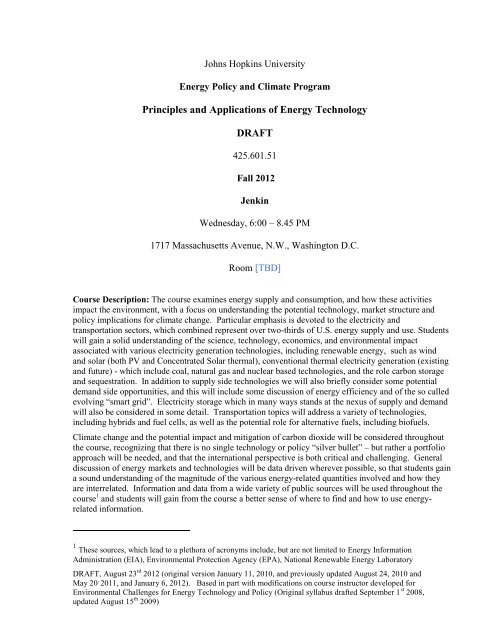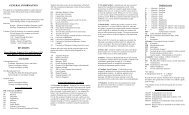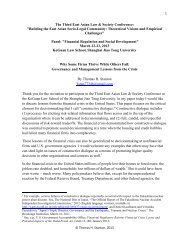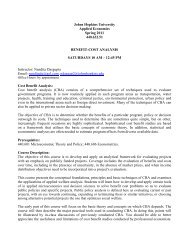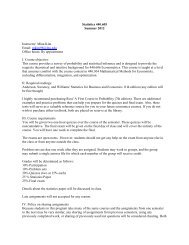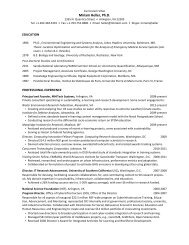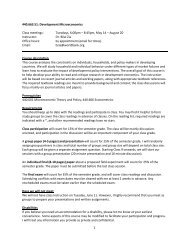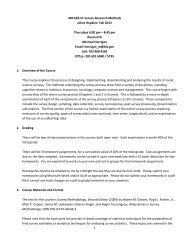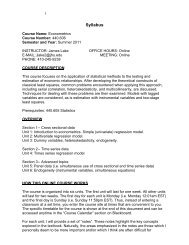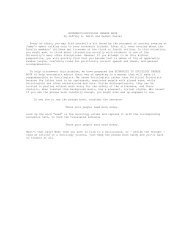Principles and Applications of Energy Technology - Advanced ...
Principles and Applications of Energy Technology - Advanced ...
Principles and Applications of Energy Technology - Advanced ...
Create successful ePaper yourself
Turn your PDF publications into a flip-book with our unique Google optimized e-Paper software.
Johns Hopkins University<strong>Energy</strong> Policy <strong>and</strong> Climate Program<strong>Principles</strong> <strong>and</strong> <strong>Applications</strong> <strong>of</strong> <strong>Energy</strong> <strong>Technology</strong>DRAFT425.601.51Fall 2012JenkinWednesday, 6:00 – 8.45 PM1717 Massachusetts Avenue, N.W., Washington D.C.Room [TBD]Course Description: The course examines energy supply <strong>and</strong> consumption, <strong>and</strong> how these activitiesimpact the environment, with a focus on underst<strong>and</strong>ing the potential technology, market structure <strong>and</strong>policy implications for climate change. Particular emphasis is devoted to the electricity <strong>and</strong>transportation sectors, which combined represent over two-thirds <strong>of</strong> U.S. energy supply <strong>and</strong> use. Studentswill gain a solid underst<strong>and</strong>ing <strong>of</strong> the science, technology, economics, <strong>and</strong> environmental impactassociated with various electricity generation technologies, including renewable energy, such as wind<strong>and</strong> solar (both PV <strong>and</strong> Concentrated Solar thermal), conventional thermal electricity generation (existing<strong>and</strong> future) - which include coal, natural gas <strong>and</strong> nuclear based technologies, <strong>and</strong> the role carbon storage<strong>and</strong> sequestration. In addition to supply side technologies we will also briefly consider some potentialdem<strong>and</strong> side opportunities, <strong>and</strong> this will include some discussion <strong>of</strong> energy efficiency <strong>and</strong> <strong>of</strong> the so calledevolving “smart grid”. Electricity storage which in many ways st<strong>and</strong>s at the nexus <strong>of</strong> supply <strong>and</strong> dem<strong>and</strong>will also be considered in some detail. Transportation topics will address a variety <strong>of</strong> technologies,including hybrids <strong>and</strong> fuel cells, as well as the potential role for alternative fuels, including bi<strong>of</strong>uels.Climate change <strong>and</strong> the potential impact <strong>and</strong> mitigation <strong>of</strong> carbon dioxide will be considered throughoutthe course, recognizing that there is no single technology or policy “silver bullet” – but rather a portfolioapproach will be needed, <strong>and</strong> that the international perspective is both critical <strong>and</strong> challenging. Generaldiscussion <strong>of</strong> energy markets <strong>and</strong> technologies will be data driven wherever possible, so that students gaina sound underst<strong>and</strong>ing <strong>of</strong> the magnitude <strong>of</strong> the various energy-related quantities involved <strong>and</strong> how theyare interrelated. Information <strong>and</strong> data from a wide variety <strong>of</strong> public sources will be used throughout thecourse 1 <strong>and</strong> students will gain from the course a better sense <strong>of</strong> where to find <strong>and</strong> how to use energyrelatedinformation.1 These sources, which lead to a plethora <strong>of</strong> acronyms include, but are not limited to <strong>Energy</strong> InformationAdministration (EIA), Environmental Protection Agency (EPA), National Renewable <strong>Energy</strong> LaboratoryDRAFT, August 23 rd 2012 (original version January 11, 2010, <strong>and</strong> previously updated August 24, 2010 <strong>and</strong>May 20 , 2011, <strong>and</strong> January 6, 2012). Based in part with modifications on course instructor developed forEnvironmental Challenges for <strong>Energy</strong> <strong>Technology</strong> <strong>and</strong> Policy (Original syllabus drafted September 1 st 2008,updated August 15 th 2009)
The role <strong>of</strong> risk <strong>and</strong> uncertainty will be highlighted throughout the course where appropriate. Broadly,there is tremendous uncertainty about how the future will unfold, including: if <strong>and</strong> when a policy will beimplemented, what the impact <strong>of</strong> a policy will be, whether or not some new technologies will becomefeasible at all, <strong>and</strong> if so when <strong>and</strong> at what cost (both in terms <strong>of</strong> required investment <strong>and</strong> environmentalimpact).It is should be evident from the significant breadth <strong>of</strong> this course that there will be a need to be selectivein the depth <strong>of</strong> coverage, <strong>and</strong> this will be the case; a more detailed treatment <strong>of</strong> some topics covered inthis course potentially lend themselves to entire courses e.g. transportation. Lectures <strong>and</strong> discussion willfocus on conveying the fundamental science <strong>and</strong> technology, economic, <strong>and</strong> environmental impact in aclear straightforward, but not simplistic manner. There is a significant benefit to providing the broaderenergy picture in this way because many <strong>of</strong> these topics <strong>and</strong> approaches are inherently interlinked. Insummary, the course will provide the core underlying principles <strong>and</strong> ideas, as well as provide numerouscitations <strong>and</strong> sources that will enable the student during the course, or later, to pursue areas <strong>of</strong> interest ingreater depth.Teaching Style: The course will be delivered primarily through lectures <strong>and</strong> discussion. One <strong>of</strong> theprimary goals <strong>of</strong> this course is for all students to gain a good grasp <strong>of</strong> underlying scientific, economic, <strong>and</strong>environmental principles associated with both individual technologies <strong>and</strong> portfolios <strong>of</strong> technologies. Themathematics used will be kept at a straightforward level.Instructor: Dr. Thomas Jenkin is a Senior <strong>Energy</strong> Analyst at the National Renewable <strong>Energy</strong>Laboratory (NREL) in Washington DC. He can be contacted by phone at (202) 488-2219 or by e-mail at Tjenki23@jhu.edu. He developed this course <strong>and</strong> first taught it in Spring 2010 (<strong>and</strong>subsequently in Fall 2010, Summer 2011 <strong>and</strong> Spring 2012). He has also developed <strong>and</strong> taught otherrelated energy courses at Johns Hopkins since 2008.Course Requirements: The main method <strong>of</strong> grading beyond some consideration <strong>of</strong> classparticipation will be through problem sets. Over the course there will be four problem sets h<strong>and</strong>edout that each need to be completed within two weeks. The problems sets will contain both conceptual<strong>and</strong> numeric problems, <strong>and</strong> students are encouraged to work together if that makes sense tounderst<strong>and</strong> ideas, though each student needs to h<strong>and</strong> in their own work. The problems sets will bedesigned consolidate underst<strong>and</strong>ing <strong>of</strong> the course material covered (rather than test innatemathematics ability).Grading: In determining grades for the course, class participation, exams <strong>and</strong> papers will beweighted as indicated below.(1) Class participation 20%(2) Problem Sets 80%Course Readings:There is no required text for the parts <strong>of</strong> the course that deal with economic, environmental impact<strong>and</strong> policy in depth, <strong>and</strong> indeed parts <strong>of</strong> the technology <strong>and</strong> science. These areas will be covered bythrough the lectures <strong>and</strong> through assigned papers <strong>and</strong> reports that will be available on the internet,electronically via JHU or h<strong>and</strong>ed out (see Syllabus <strong>and</strong> Readings for the preliminary list).(NREL), Resources for the Future (RFF), Federal <strong>Energy</strong> Regulatory Commission (FERC), World ResourcesInstitute (WRI), Intergovernmental Panel on Climate Change (IPCC), Lawrence Berkeley National Laboratory(LBNL), International <strong>Energy</strong> Agency (IEA), the Department <strong>of</strong> <strong>Energy</strong>’s (DOE) Office <strong>of</strong> <strong>Energy</strong> Efficiency<strong>and</strong> Renewable <strong>Energy</strong> (EERE), <strong>and</strong> the American Wind <strong>Energy</strong> Association (AWEA).DRAFT, August 23 rd 2012 (original version January 11, 2010, <strong>and</strong> previously updated August 24, 2010 <strong>and</strong>May 20 , 2011, <strong>and</strong> January 6, 2012). Based in part with modifications on course instructor developed forEnvironmental Challenges for <strong>Energy</strong> <strong>Technology</strong> <strong>and</strong> Policy (Original syllabus drafted September 1 st 2008,updated August 15 th 2009)
There is, however one required text that supports parts <strong>of</strong> the science <strong>and</strong> technology aspects <strong>of</strong> thecourse, as well as some parts <strong>of</strong> the economic <strong>and</strong> environmental impact. This text isAndrews, John <strong>and</strong> Jelly, Nick, <strong>Energy</strong> Science: <strong>Principles</strong>, Technologies <strong>and</strong> Impacts,Oxford University Press (2007)It is important to note that this text (“<strong>Energy</strong> Science (Andrews & Jelley (2007))”) will, at times g<strong>of</strong>urther than the course lectures into the science (both in terms <strong>of</strong> a slightly different coverage <strong>of</strong>technologies (broader than this course in some areas, narrower in others)), as well as going into moretechnical detail for some <strong>of</strong> the technologies we do cover, but will be a useful future resource. 2 Onthe other h<strong>and</strong> as mentioned earlier, this course we will go much further into the economics,environmental impact, market <strong>and</strong> resource considerations than this text.One recent report issued by the US Department <strong>of</strong> <strong>Energy</strong> provides a lot <strong>of</strong> visual information thatsets out how much renewable energy there is in the US <strong>and</strong> worldwide, by technology type, bothcurrently - <strong>and</strong> showing changes over the last 10 year. It is a bit much to read or look at “all at once”– but you should find it very useful to get a better sense <strong>of</strong> the current “market” as we go through thecourse.US Department <strong>of</strong> <strong>Energy</strong>, 2010 Renewable <strong>Energy</strong> Data Book, (2011)Other readings will be distributed in class or by e-mail or assigned from the internet (See ReadingList below). Please note that the syllabus will be updated from time to time to incorporate additionalreadings.Field Trip (Optional)When the course was last given in Spring 2012 a weekday afternoon field trip to a nearby municipalwaste-to-electricity thermal power plant* was arranged (from 3pm to 5pm). Many students were ableto attend <strong>and</strong> found it both enjoyable <strong>and</strong> interesting. It is hoped to arrange a similar trip this Fall forstudents. 32 The course also assumes less scientific background than this book <strong>and</strong> so covers some <strong>of</strong> these topics morecomprehensively, in a sense from the “ground up”, with an emphasis on providing the physical intuition behindhow these technologies work.3 Unfortunately the plant only receives visits during working hoursDRAFT, August 23 rd 2012 (original version January 11, 2010, <strong>and</strong> previously updated August 24, 2010 <strong>and</strong>May 20 , 2011, <strong>and</strong> January 6, 2012). Based in part with modifications on course instructor developed forEnvironmental Challenges for <strong>Energy</strong> <strong>Technology</strong> <strong>and</strong> Policy (Original syllabus drafted September 1 st 2008,updated August 15 th 2009)
Syllabus <strong>and</strong> ReadingsGeneral CommentThe classes will follow the syllabus below quite closely, with the following caveats. Depending on classinterest <strong>and</strong> level <strong>of</strong> discussion some topics may take slightly longer or shorter than suggested by thesimple to 1 to 12 numbering. In particular wind <strong>and</strong> solar are both closer to about 1.5 to 2 classes each[where each class is assumed to be 2 hrs <strong>and</strong> 45 minutes with a few brief breaks], which is <strong>of</strong>fset in part inthe syllabus with some other topics occupying less than a class (e.g. which applies to both carbon capture<strong>and</strong> sequestration (CCS) <strong>and</strong> electricity storage). Conventional generation, which includes coal, nuclear<strong>and</strong> natural gas generation, <strong>and</strong> includes discussions <strong>of</strong> real <strong>and</strong> idealized “heat engines” covers about 2classes (<strong>and</strong> possibly a little more) as indicated by (6&7).1: Introduction <strong>and</strong> <strong>Energy</strong> Supply <strong>and</strong> Dem<strong>and</strong>: United States <strong>and</strong> WorldwideThis part <strong>of</strong> the course provides an overview <strong>of</strong> the topics <strong>and</strong> major issues to be addressed in the course,as well as a discussion <strong>of</strong> course mechanics <strong>and</strong> a brief introduction to the related reading materials. Theclass will then review energy supply <strong>and</strong> consumption from both a U.S. <strong>and</strong> international perspective,with a view to framing some <strong>of</strong> the major environmental challenges, especially associated withcontrolling future carbon emissions, <strong>and</strong> the likely need for a portfolio approach to reduce emissions.The class will also cover energy conversion units <strong>and</strong> a review <strong>of</strong> some <strong>of</strong> the fundamental scientificprinciples associated with energy, such as energy conservation.Pacala S. <strong>and</strong> Socolow, R. “Stabilization Wedges: Solving the Climate Problems for the Next 50 yearswith Current <strong>Technology</strong>” Science, 305, August 2004. 4<strong>Energy</strong> Information Administration, International <strong>Energy</strong> Outlook 2011 – presentation.http://www.eia.gov/pressroom/presentations/howard_09192011.pdfHoldren, John P., “The <strong>Energy</strong> Innovation Imperative: Addressing Oil Dependence, Climate Change<strong>and</strong> Other 21 st Century Challenges”, Innovations, MIT Press, Spring 2006. (Optional)http://www.mitpressjournals.org/doi/pdf/10.1162/itgg.2006.1.2.3<strong>Energy</strong> Science (Andrews <strong>and</strong> Jelley (2007)). Chapter 1 - Introduction: Sections 1.1, 1.2, 1.3 <strong>and</strong> 1.4. 52: Climate Change: Introduction to the Science <strong>and</strong> Framing <strong>of</strong> the Economics <strong>and</strong>Policy ChoicesAn overview <strong>of</strong> what climate change means from both a science <strong>and</strong> policy perspective. Specifically, itwill cover what is known <strong>and</strong> what is uncertain about climate change <strong>and</strong> how it relates to anthropogenicemissions. Much <strong>of</strong> the rest <strong>of</strong> the course will discuss various energy technologies, the implementation<strong>and</strong> operation <strong>of</strong> which may have a significant impact on mitigating future green house gas (GHG)4 Initially it will be sufficient to skim through this paper, <strong>and</strong> read it more deeply as we go through the course.5 The specific sections to be read from Chapters in <strong>Energy</strong> Science: Andrews <strong>and</strong> Jelley (2007) will be specifiedin class several weeks ahead <strong>of</strong> their use. The readings for the first four classes are included above. Thesections (e.g., 2.1, 2.2 (<strong>and</strong> so on )sometimes include more technical “derivation” boxes (in blue); thesederivations are not required reading or part <strong>of</strong> the course, unless explicitly noted. Sections are usually quiteshort typically ranging from half a page to 2 pages in lengthDRAFT, August 23 rd 2012 (original version January 11, 2010, <strong>and</strong> previously updated August 24, 2010 <strong>and</strong>May 20 , 2011, <strong>and</strong> January 6, 2012). Based in part with modifications on course instructor developed forEnvironmental Challenges for <strong>Energy</strong> <strong>Technology</strong> <strong>and</strong> Policy (Original syllabus drafted September 1 st 2008,updated August 15 th 2009)
emissions. Policy options for climate change will raised here briefly, <strong>and</strong> returned to throughout thecourse.Stern, Nicholas, “Chapter 1: The Science <strong>of</strong> Climate Change: Scale <strong>of</strong> the Environmental Challenge”,The Economics <strong>of</strong> Climate Change: The Stern Review, Cambridge University Press (2007).http://www.hmtreasury.gov.uk/independent_reviews/stern_review_economics_climate_change/stern_review_report.cfmNordhaus, William, “Chapter 1: Summary for a Concerned Citizen”, A Question <strong>of</strong> Balance:Weighing the Options on Global Warming Policies, Yale University Press (2008).Taylor, F. W. “Chapter 1: The Climate System”, Elementary Climate Physics, Oxford UniversityPress (2005). (Supplementary reading - Optional)<strong>Energy</strong> Science (Andrews <strong>and</strong> Jelley (2007)). Chapter 2 – Thermal <strong>Energy</strong>: Sections 2.1, 2.2 fromradiative heat transfer (p23). Chapter 11 – <strong>Energy</strong> <strong>and</strong> Society: Sections 11.1, 11.3, 11.5 <strong>and</strong> 11.6which cover energy <strong>and</strong> society.3: Introduction to the Electricity Sector in the United StatesThis class provides an overview <strong>of</strong> the electricity sector in the United States, with an emphasis ongeneration. It will cover both generation, <strong>and</strong> the transmission <strong>and</strong> distribution infrastructure, includingthe role <strong>of</strong> regulation <strong>and</strong> market competition. The class will cover how different types <strong>of</strong> generationcapacity (baseload, intermediate, peaking) are dispatched to meet the daily hourly load pr<strong>of</strong>iles, <strong>and</strong> howthis effects prices <strong>and</strong> environmental emissions. The economics <strong>of</strong> various generation technologies (onboth a marginal <strong>and</strong> levelized cost basis) will be covered, including the impact <strong>of</strong> fuel prices <strong>and</strong> pricevolatility. Part <strong>of</strong> the latter half <strong>of</strong> the class will cover the attempt to deregulate the California electricitymarkets <strong>and</strong> why <strong>and</strong> how the market failed in 2000.Federal <strong>Energy</strong> Regulatory Commission (FERC), “Executive Summary <strong>and</strong> Sections 1, 2 <strong>and</strong> 3”, 2006State <strong>of</strong> the Market Report (2007). 6 http://www.ferc.gov/market-oversight/st-mkt-ovr/som-rpt-2006.pdf. This report while old is more detailed in a number <strong>of</strong> ways than the more recent updates(see below)FERC “2010 State <strong>of</strong> the Markets” (2011) <strong>and</strong> 2011 State <strong>of</strong> the Markets” (2012) for more recent butbriefer updates. http://www.ferc.gov/market-oversight/reports-analyses/st-mkt-ovr/som-rpt-2010.pdfhttps://www.ferc.gov/market-oversight/reports-analyses/st-mkt-ovr/som-rpt-2011.pdfMcLean, Bethany <strong>and</strong> Elkind, Peter, “Chapter 17: Gaming California”; The Smartest Guys in theRoom: The Amazing Rise <strong>and</strong> the Sc<strong>and</strong>alous Fall <strong>of</strong> Enron, Portfolio (2003).Joskow, Paul, “California’s Electricity Crisis”, MIT whitepaper, September 28, 2001. 7http://www.hks.harvard.edu/hepg/Papers/CALIF.%20-%20Joskow%209-01-UPDATE.pdf(Supplementary reading - Optional)6 The 2006 report is used because it is much shorter than the later reports, <strong>and</strong> useful to introduce some keyideas <strong>and</strong> figures in electric (<strong>and</strong> natural gas) markets. 2010 <strong>and</strong> 2011 presentations provide update <strong>of</strong> somemarket information.7 This paper is quite long. Skim through it initially, though it is useful for underst<strong>and</strong>ing how the realchallenges associated with deregulating power markets.DRAFT, August 23 rd 2012 (original version January 11, 2010, <strong>and</strong> previously updated August 24, 2010 <strong>and</strong>May 20 , 2011, <strong>and</strong> January 6, 2012). Based in part with modifications on course instructor developed forEnvironmental Challenges for <strong>Energy</strong> <strong>Technology</strong> <strong>and</strong> Policy (Original syllabus drafted September 1 st 2008,updated August 15 th 2009)
<strong>Energy</strong> Science (Andrews <strong>and</strong> Jelley (2007)). Chapter 2 – Thermal <strong>Energy</strong>: Sections 2.3, 2.4. onefficiency <strong>of</strong> thermal power plants Chapter 10: Section 10.1* on power generation, Chapter 11,Section 11.2 on economics <strong>of</strong> power plants.4: Wind Power <strong>and</strong> HydroThe majority <strong>of</strong> this class will cover wind power. Specifically, it will cover the science behind thetechnology (“how it works”), the economics <strong>and</strong> environmental impact <strong>of</strong> wind farms <strong>and</strong> also discusssome market structure, policy <strong>and</strong> resource considerations, including the use <strong>of</strong> economic incentives (suchas production tax credits (PTCs)), technological improvements, installed capacity <strong>and</strong> how changingfossil fuel prices <strong>and</strong> other commodity costs are affecting the relative <strong>and</strong> absolute economics <strong>of</strong> thistechnology. The latter part <strong>of</strong> the class will cover hydroelectric power which has some interestingsimilarities <strong>and</strong> differences to wind.Note: A similar approach – with varying degrees <strong>of</strong> detail <strong>and</strong> rigor, will be used for other technologiesWiser, Ryan <strong>and</strong> Bollinger, Mark, 2010 Wind Technologies Market Report, Lawrence BerkeleyNational Laboratory for the U.S Department <strong>of</strong> <strong>Energy</strong>, <strong>Energy</strong> Efficiency <strong>and</strong> Renewable <strong>Energy</strong>,June 2011. http://eetd.lbl.gov/ea/emp/reports/lbnl-4820e.pdfBonneville Power Administration, Hydropower: How the Federal Columbia River Power Systemworks for you, (2011)*. http://www.bpa.gov/corporate/pubs/Hydro_101.pdf,http://www.bpa.gov/power/pg/fcrps_brochure_17x11.pdfStone, Richard. “Three Gorges Dam: Into the Unknown” Science, 321, August 2008.Department <strong>of</strong> <strong>Energy</strong>, “Executive Summary <strong>and</strong> Overview”, 20% Wind <strong>Energy</strong> by 2030: IncreasingWind <strong>Energy</strong>’s Contribution to U.S. Electricity Supply, DOE/GO-102008-2567, May 2008*.http://www1.eere.energy.gov/wind<strong>and</strong>hydro/pdfs/41869.pdf (Supplementary reading - Optional)<strong>Energy</strong> Science (Andrews <strong>and</strong> Jelley (2007)). Chapter 5 - Wind Power: Sections 5.1 to 5.5, 5.7* <strong>and</strong>5.9 to 5.16, <strong>and</strong> Chapter 4 - Hydropower, Wave Power <strong>and</strong> Tidal Power: Sections 4.1, 4.2, 4.4.1 <strong>and</strong>4.5 for hydropower <strong>and</strong> 4.6*, 4.7 <strong>and</strong> 4.8 for tidal power.5: Solar <strong>Energy</strong>The majority <strong>of</strong> this class will cover solar energy <strong>and</strong> focus on the two main technologies – Photovoltaiccells (PV) <strong>and</strong> Concentrated Solar Power (CSP), with more emphasis on the former, including its use asdistributed or grid-independent resources. As for wind the class will cover the science (“how it works”),economics <strong>and</strong> environmental impact <strong>of</strong> solar technologies <strong>and</strong> also discuss some market structure, policy<strong>and</strong> resource considerations. PV discussion will range from single cell silicon PV to the use <strong>of</strong> multijunctioncells (<strong>of</strong>ten) in concentrated PV.McConnell, Robert <strong>and</strong> Symko-Davis, Martha, “ What’s New in Concentrating PV” , PV FAQ, U.SDepartment <strong>of</strong> <strong>Energy</strong>, <strong>Energy</strong> Efficiency <strong>and</strong> Renewable <strong>Energy</strong> (2008).Kutcher, Charles F. “Chapters on CSP <strong>and</strong> PV”, Tackling Climate Change in the U.S.: PotentialCarbon Emissions Reductions from <strong>Energy</strong> Efficiency <strong>and</strong> Renewable <strong>Energy</strong> by 2030, AmericanSolar <strong>Energy</strong> Society, January 2007. http://ases.org/images/stories/file/ASES/climate_change.pdf(Supplementary reading - Optional)<strong>Energy</strong> Science (Andrews <strong>and</strong> Jelley (2007)). Chapter 6 - Solar <strong>Energy</strong>: Sections 6.1, 6.2, 6.3*, 6..4,6.5, 6.6, 6.7.2, 6.8, 6.9, 6.10, 6.11DRAFT, August 23 rd 2012 (original version January 11, 2010, <strong>and</strong> previously updated August 24, 2010 <strong>and</strong>May 20 , 2011, <strong>and</strong> January 6, 2012). Based in part with modifications on course instructor developed forEnvironmental Challenges for <strong>Energy</strong> <strong>Technology</strong> <strong>and</strong> Policy (Original syllabus drafted September 1 st 2008,updated August 15 th 2009)
.6 &7: Conventional Generation: Coal, Gas <strong>and</strong> NuclearThis selection <strong>of</strong> topics, which is likely to be two classes will cover “conventional” generation,specifically coal, natural gas <strong>and</strong> nuclear powered technologies following a similar format to the earliertreatment <strong>of</strong> renewable energy technologies. Both current <strong>and</strong> anticipated future technologies, such asIntegrated Gasification Combined Cycle (IGCC) will be covered. All these technologies work on theprinciple <strong>of</strong> a “heat engine” which places significant physical limits on achievable energy efficiency <strong>of</strong>conversion <strong>of</strong> heat to useful work (in this case mechanical energy which is then converted to electricity),<strong>and</strong> this will be explained. To do this we will cover some basic ideas in thermodynamics (energyconservation (1 st law) <strong>and</strong> limits to energy conversion to useful work (as in generating electricity, say)(2 nd law, including the concept <strong>and</strong> use <strong>of</strong> entropy). Idealized (Carnot) <strong>and</strong> real heat-to useful work“engines”, including the thermal steam turbine (using Rankine Cycle) <strong>and</strong> gas or combustion turbine (CT)(using a Brayton cycle) will be considered.It is critical to underst<strong>and</strong> the potential role <strong>of</strong> these technologies since they represent the vast majority <strong>of</strong>the existing sources <strong>of</strong> power, <strong>and</strong> are likely to play a prominent role going forward, though the exact rolewill be dependent <strong>of</strong> policies, technological improvements <strong>and</strong> natural resources; it is also likely to varysignificantly by country. The environmental impact <strong>of</strong> these technologies <strong>and</strong> technological barriers t<strong>of</strong>uture investment vary markedly <strong>and</strong> these issues will be discussed.These technologies <strong>of</strong>ten have significant advantages (nuclear from a carbon mitigation perspective) <strong>and</strong>challenges (e.g. coal, <strong>and</strong> to a lesser extent gas from a carbon perspective <strong>and</strong> nuclear from treatment <strong>of</strong>waste <strong>and</strong> potential nuclear proliferation concerns). These issues will be discussed explicitly.Technologies used in the US to reduce “acid rain” resulting from SO 2 <strong>and</strong> NO x emissions, primarily fromcoal generation will also be discussed briefly.Deutch, John, <strong>and</strong> Moniz, Ernest J. (Co-Chairs), “Chapter 2: The Role <strong>of</strong> Coal in <strong>Energy</strong> Growth <strong>and</strong>CO2 Emissions”, “Chapter 3: Coal-Based Electricity Generation” The Future <strong>of</strong> Coal, MITInterdisciplinary Study (2007). http://web.mit.edu/coal/Fowler, Michael, “Heat Engines: The Carnot Cycle”, from course notes <strong>of</strong> “Heat <strong>and</strong>Thermodynamics”, University <strong>of</strong> Virginia (2008).EPA, Cap <strong>and</strong> Trade: Acid Rain Basics. http://www.epa.gov/airmarkt/cap-trade/docs/arbasics.pdfEPA, Cap <strong>and</strong> Trade: Acid Rain Program Results. http://www.epa.gov/airmarkt/captrade/docs/ctresults.pdf<strong>Energy</strong> Science (Andrews <strong>and</strong> Jelley (2007)). Chapter 2 – Thermal <strong>Energy</strong>: Sections 2.3, 2.4, 2.5, 2.6,2.7, 2.8, 2..10 <strong>and</strong> 2.11; Chapter 8 – <strong>Energy</strong> from Fission: Sections 8.1, 8.2, 8.2.1, 8.2.2, 8.2.3*, 8.3*,8.4, 8.5*, 8.6 to 8.11.8: Carbon Capture <strong>and</strong> Sequestration (CCS)An important consideration <strong>of</strong> whether coal technology becomes an environmentally attractive option iswhether the carbon dioxide emissions can be separated <strong>and</strong> then stored (or sequestrated) in a costeffective manner. This class will cover carbon capture <strong>and</strong> sequestration, <strong>and</strong> will include discussion <strong>of</strong>technological, economics, environmental <strong>and</strong> policy challenges, <strong>and</strong> well as how the role <strong>of</strong> uncertaintyfactors into investment decisions; to a considerable extent the economic feasibility <strong>of</strong> CCS is likely todepend on how future carbon dioxide emissions are priced.IPCC, “Technical Summary”, IPCC Special Report: Carbon Dioxide Capture <strong>and</strong> Sequestration(2005). http://www.ipcc.ch/pdf/special-reports/srccs/srccs_technicalsummary.pdfDRAFT, August 23 rd 2012 (original version January 11, 2010, <strong>and</strong> previously updated August 24, 2010 <strong>and</strong>May 20 , 2011, <strong>and</strong> January 6, 2012). Based in part with modifications on course instructor developed forEnvironmental Challenges for <strong>Energy</strong> <strong>Technology</strong> <strong>and</strong> Policy (Original syllabus drafted September 1 st 2008,updated August 15 th 2009)
Herzog, Howard <strong>and</strong> Katzner, James “The Future <strong>of</strong> Coal in a Greenhouse Gas Constrained World”MIT paper (2004). http://sequestration.mit.edu/pdf/GHGT8_Herzog_Katzer.pdf (Supplementaryreading – Optional)9: Electricity Storage & Integration Issues & GeothermalThis class first will cover the potential role electricity storage. There are a variety <strong>of</strong> potential electricitystorage technologies, including pumped hydro, compressed air energy storage (CAES), batteries <strong>and</strong>capacitors that can provide an array <strong>of</strong> grid <strong>and</strong> generation applications, that in principle could lead to amore operationally efficient grid, including deferring the need for new transmission <strong>and</strong> distributionbuild, <strong>and</strong> facilitating the integration <strong>of</strong> large amounts <strong>of</strong> wind. There are a number <strong>of</strong> barriers to thelarge scale implementation <strong>of</strong> storage, however, including cost <strong>and</strong> market structure considerations. Theenvironmental benefits <strong>of</strong> storage are less clear cut, <strong>and</strong> somewhat application <strong>and</strong> location specific, <strong>and</strong>this will be discussed.A second topic covered will be geothermal energy. This is really quite a separate topic from storagecovered above – though it does use energy stored in the Earth’s crust.Sioshansi Ramteen, Denholm, Paul, Jenkin, Thomas <strong>and</strong> Weiss, Jurgen, “Estimating the Value <strong>of</strong>Electricity Storage in PJM: Arbitrage <strong>and</strong> Some Welfare Effects”, <strong>Energy</strong> Economics, 31, 269-277,March 2009.<strong>Energy</strong> Science (Andrews <strong>and</strong> Jelley (2007)). Chapter 10 - Generation <strong>and</strong> Transmission <strong>of</strong>Electricity, <strong>Energy</strong> Storage, <strong>and</strong> Fuel Cells: Sections 10.5 to 10.14 on storage technologies <strong>and</strong> fuelcells.10: Biomass <strong>Energy</strong> <strong>and</strong> Introduction to TransportationThis class will cover Biomass <strong>and</strong> Bi<strong>of</strong>uels; what they are, their sources, <strong>and</strong> how they can be used forheat, power generation <strong>and</strong> transportation. The class will include discussion <strong>of</strong> whether bi<strong>of</strong>uels can beconsidered largely carbon neutral, the relative effectiveness <strong>of</strong> different biomass sources (sugar cane vs.corn vs. cellulosic), including the social <strong>and</strong> policy implications <strong>of</strong> subsidies <strong>and</strong> competing uses for l<strong>and</strong>(e.g. food vs. fuel), <strong>and</strong> their potential value in reducing dependence on oil.Childs Staley, Britt <strong>and</strong> Bradley, Rob,”Plants at the Pump: Reviewing Bi<strong>of</strong>uels’ Impacts <strong>and</strong> PolicyConsiderations”, Climate <strong>and</strong> <strong>Energy</strong> Policy Series, , World Resources Institute, July 2008.http://pdf.wri.org/plants_at_the_pump_brief.pdf<strong>Energy</strong> Science (Andrews <strong>and</strong> Jelley (2007)). Chapter 7 - Biomass: Sections 7.1 to 7.6 [Completechapter]. The entire chapter is worth readingChilds Staley, Britt <strong>and</strong> Bradley, Rob, Plants at the Pump: Bi<strong>of</strong>uels, Climate Change <strong>and</strong>Sustainability, World Resources Institute, December 2007. http://pdf.wri.org/plants_at_the_pump.pdf(Supplementary reading – Optional)Fargione et al, “L<strong>and</strong> Clearing <strong>and</strong> the Bi<strong>of</strong>uel Carbon Debt”, Science, 319, 1235, February 29, 2008. 8(Supplementary reading – Optional)11: Transportation8 There is quite a highly charged debate going on over the benefits <strong>and</strong> costs <strong>of</strong> biomass from a carbonneutrality perspective. This paper covers one side <strong>of</strong> the argument. Other papers will be added to this syllabusto facilitate a class discussion on the topic. It should not be assumed necessarily that the instructor endorseseverything written in this paper, or for that matter other reading material.DRAFT, August 23 rd 2012 (original version January 11, 2010, <strong>and</strong> previously updated August 24, 2010 <strong>and</strong>May 20 , 2011, <strong>and</strong> January 6, 2012). Based in part with modifications on course instructor developed forEnvironmental Challenges for <strong>Energy</strong> <strong>Technology</strong> <strong>and</strong> Policy (Original syllabus drafted September 1 st 2008,updated August 15 th 2009)
The transportation sector is a major user <strong>of</strong> crude oil, <strong>and</strong> in the United States there is significant desire toreduce dependence on oil for transportation for both environmental <strong>and</strong> security reasons. Reduced oildependence <strong>and</strong> lower carbon emissions may come about from an array <strong>of</strong> potential alternative vehicletechnologies <strong>and</strong> fuels, including the use <strong>of</strong> ethanol, (fuel-battery) hybrids (including plug-ins) <strong>and</strong> fuelcells, some <strong>of</strong> which have major infrastructure <strong>and</strong> policy implications. The various technology optionswill be discussed.12: <strong>Energy</strong> Efficiency – Dem<strong>and</strong> Side Considerations, including the Smart Grid<strong>Energy</strong> efficiency improvements represent an important way to significantly reduce the use fossil fuels ina cost-effective manner. From a generation <strong>and</strong> transportation perspective this has largely been coveredin earlier classes. This class will focus on energy efficiency from a dem<strong>and</strong> side perspective (e.g.buildings <strong>and</strong> industry <strong>and</strong> dem<strong>and</strong>-side management in the power sector). The penetration <strong>of</strong> someexisting dem<strong>and</strong>-side technologies is remarkably low given their currently realizable economic benefits<strong>and</strong> some the reasons for this, <strong>and</strong> potential policy solutions will be discussed.Rosenfeld, Art, “The “Art” <strong>of</strong> <strong>Energy</strong> Efficiency: Protecting the Environment with Better<strong>Technology</strong>”, Annual Review <strong>of</strong> <strong>Energy</strong> <strong>and</strong> the Environment, 24, 33-88, 1999.Friedman, Thomas, “Chapter 10: The <strong>Energy</strong> Internet: When IT Meets ET”; Hot, Flat <strong>and</strong> Crowded,Farar, Strauss <strong>and</strong> Giroux (2008).Farrell, Diana <strong>and</strong> Remes, Jaana, “How the World Should Invest in <strong>Energy</strong> Efficiency”, TheMcKinsey Quarterly July 2008.Tversky, Amos <strong>and</strong> Kahneman, Daniel, “The Framing <strong>of</strong> Decisions <strong>and</strong> the Psychology <strong>of</strong>Choice”, Science, 211: 453-458 (1981).DRAFT, August 23 rd 2012 (original version January 11, 2010, <strong>and</strong> previously updated August 24, 2010 <strong>and</strong>May 20 , 2011, <strong>and</strong> January 6, 2012). Based in part with modifications on course instructor developed forEnvironmental Challenges for <strong>Energy</strong> <strong>Technology</strong> <strong>and</strong> Policy (Original syllabus drafted September 1 st 2008,updated August 15 th 2009)


